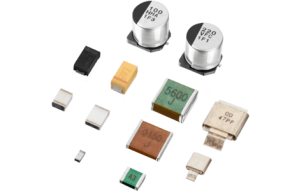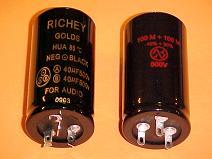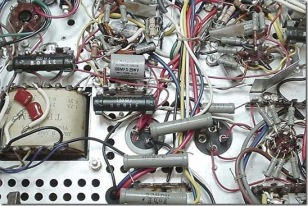I was looking at boutique tube amp websites, since I’m in that business. I’m looking to see what other builders’ websites look like, what they’re selling, what their prices are, etc. I’m often amazed by the amount of marketing lingo, and frankly, total BS that can be found on some of these sites. I will list a few of these.
Period-Correct Transformers
This one is pure BS. Household voltages in the 1950s were perhaps 10 volts lower than they are in 2017. Therefore, if you take an amplifier built in the 1950s and run it on today’s power, the test/idle voltages, bias numbers, etc., will all be off. The high voltage may as much as 30 Volts DC above specification.
However, an amp built today is built with transformers designed for 120V operation, so that negates any need for “period-correct transformers.” As a matter of fact, if a 1957 amplifier uses a 115/650VAC transformer, and a new amp uses a 125/650 volt transformer, guess what- they both put out 650VAC, it’s just that one does it with a 115V input, and another does it with a 125V input.
While it’s true that if you run are using an old amp from the ’50s today your voltages will be too high, a new amp is designed for today’s higher line voltages. A “Period-correct transformer” only matters if you’re replacing a power transformer in an old amp. To that end, some of the new replacement transformers have two primary taps. One example used in my amps has a 115V primary and a 125V primary. Bear in mind also, that although 120 VAC is the modern U.S. standard, actual measured voltage is plus or minus 5%. I usually see 122 Volts in my shop. When I test my amplifiers, I always use a variable AC transformer to test at 120VAC.
Tube vs. Solid-State Rectifiers
I read on one site about an amp’s tube rectifier having excellent sonics due to a lack of solid-state components. That’s debatable enough, as many guitarists like the sound of their solid state amps, but then he goes on to say that solid-state rectifiers slam the tubes on power-up causing excess tube wear. That is simply not true!
Tube-rectified amps generally behave differently than solid-state diode rectified amps. In general, solid-state diode amps are “tighter” than tube-rectified amps, and tube-rectified amps generally exhibit a bit of voltage “sag” under high loads, leading toward a compressed sustain. Again, in general. Some people like solid-state rectified amps, and those amps have excellent sonics. Amps such as a Twin Reverb® of Vibro-King® have solid-state rectifiers and excellent sonics. My Texas Tone™ Ranger comes with a solid-state rectifier, and can also use a tube rectifier.
Solid-state rectifiers do not “slam the tubes on power-up.” In fact, the type of rectifier has nothing at all to due with slamming the tubes on power up! That particular symptom is a function of the Standby switch. The Twin Reverb® and Vibro-King® use solid-state rectifiers and a Standby switch. When a Standby switch is used on startup, waiting 15 seconds between turning on the power switch and switching the standby switch on, then there is no slamming the tubes on power-up, regardless of the type of rectifier.
The whole idea of slamming the tubes on power up is debatable anyway. Books have been written about it. The official tube manuals speak of things such as “cathode stripping” and the need for standby switches, but add a qualifier, “except for receiving tubes.” Tubes used in guitar amplifiers are all receiving tubes. Some tube rectifiers heat up gradually, and don’t even need a Standby switch. I like to use a Standby switch, and I isolate them for trouble and noise-free operation.
Cathode-Biased Watts
Some boutique amp builders claim that their cathode-biased 6V6 tube amps produce 18-22 Watts with two 6V6 tubes in a Class AB push-pull configuration. Um, no. With 350V plate voltage you might get 13 or 14 watts. If you’re running 420V B+ you might even be able to get to 16 watts. By the way. the 1955 GE tube data lists 315 V DC maximum for their 6V6GT tube; a modern JJ 6V6S indicates a 500VDC maximum. Either way, you’re going to be hard-pressed to get more than 16 Watts from any cathode-biased push-pull 6V6 amp, and that’s running way-above-spec (for anything but a JJ 6V6S) plate voltage (some people call the JJ 6v6S a cross between a 6V6 and 6L6). I don’t know where they’re getting those 18-22 Watt numbers. Instantaneous millisecond peaks at the speaker with 50% total harmonic distortion? I don’t know. I rate my amps in real, tested Watts. My cathode-biased 6V6 push-pull amps will output around 14 Watts +/- 2W, depending upon the model. No BS.
Surface-Mounted Components
One builder claimed a “surface mount capacitor” as the main power supply filtering device. Huh? Then he includes a photo and the model of the capacitor. It’s not a surface-mount capacitor. It’s a multi-section can electrolytic capacitor, the same one used in hundreds of other amplifiers.
These are surface-mount capacitors, not used for power supply filtering in tube amps (they’re tiny, smaller than a dime):

This are multi-section can, of the type used in tube amps (they’re about the size of D cell batteries):

Point-to-Point Wiring
Don’t get me started. I wrote a whole blog on this. I do not use “point-to-point’ wiring. With point-to-point wiring, each component is connected to a tube pin or solder lug or jack. There are no “boards” whatsoever. Examples of this style of construction include most old tube hi-fi equipment, 70-era Sunns, and more recently BadCat and Carr. I sturdily mount all passive components on turret boards or tag boards. Wires are carefully routed to avoid noise and cross-talk, and I color-code all wiring for easy tracing.
True point-to-point wiring example:

Turret board wiring example:

I looked inside one award-winning boutique amplifier advertising 100% true point-to-point wiring. He is correct, and it’s a mess inside, with gobs of silicone holding everything in place and wires and components everywhere. On the other hand, I see other builders that seem to be neat-freaks, with wires tied together in bundles, which is a recipe for noise. Neatness counts, but neatness in correct wire dress, not looks. Substance over flash is one of my values.
It matters not whether an amp uses a PC board, tag board, turret board or true point-to-point wiring. What matters is whether the components are sturdily mounted and selected for long life, laid out logically, and that signal, power, and heater pathways are routed for low noise and easy troubleshooting, and that you tell the truth about your amps. Rest assured that all of these criteria are met in Texas Tone™ amps. In many cases, the hiss is so low that you have to play your guitar to verify that the amp is turned on. It’s why power lights are so important!
Be aware
Don’t fall for marketing BS. Don’t just buy an amplifier because your guitar hero plays one. Do you play and sound exactly like your guitar hero? If not, then using the same guitar and amp won’t make you sound like him. I can play with a Twin and a 335, and I still don’t sound like BB King, nor if I use a Strat and a Marshall stack will I sound like Hendrix.
If you want a reliable amplifier, with high quality components, low-noise and easy troubleshooting wire routing, and above all great tone with no BS, chose Texas Tone™. Why? Because “Your TONE Matters”.

I’m not going to lie to you or trick you into buying one of my amps with marketing lingo.
Thanks.
